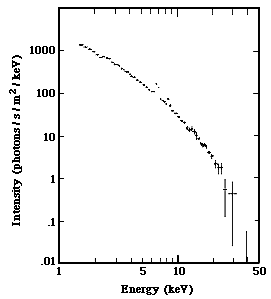Lesson Plans: Stars and Slopes
 |
Stars and Slopes |
Day 2
Day 2 delves into how to use log-log plots to gain insight into certain celestial objects of interest to X-ray astronomers.
Day 2 is still under development!
Materials
| Teacher | Students |
|---|---|
| overhead to emphasize points of the Engagement | calculator |
| set of Crab data | metric ruler |
| plot of Crab data | set of Crab data |
| few sheets of log-log graph paper |
Engagement
Now we are ready to apply our knowledge of log-log plotting to investigate various celestial objects, and the physical differences between them.The sources that you see listed below are defined by certain properties that might be new to your students. For them to fully understand these objects, select from the following:
Guided Activity
For those interested in understanding the physics behind why certain kinds of celestial objects have certain kinds of spectral slopes, this section is for you! You may skip directly to the section on "What am I?", however we encourage the investigation and discussion of some of the physics within these sources to begin with you and your students.X-ray measurements provide the most direct probes of astrophysical environments with temperatures above 1,000,000 K. The field of X-ray spectroscopy, or looking at the X-ray emission of celestial objects as a function of energy, has come into its own in the past decade or so as an extremely powerful tool in understanding our Universe. In the following discussion, we will greatly simplify the real world by ignoring factors such as the presence of strong magnetic fields, the limited resolving powers of X-ray telescopes, and so on. Instead, we will take a simplified look at the Universe and focus only on the following idea:
Slope has to do with the physical mechanism which is responsible for the emission of the X-ray photon, and different kinds of celestial objects can be dominated by different emission mechanisms.
We will examine the following emission mechanisms in this lesson: Synchrotron Emission/ Compton Scattering, Bremsstrahlung, and Blackbody Radiation.
Bremsstrahlung is radiation associated with the acceleration of electrons in the electrostatic fields of the ions and the nuclei of atoms in the material through which the electron is passing. In the 1930s, scientists noticed that the ionization loss rate that was expected for an electron underestimated the true value as the electron became relativistic. It was realized that an additional loss mechanism was present and associated with the radiation of electromagnetic waves because of the acceleration of the electron in the electrostatic field of the nucleus. This radiation is called 'braking radiation' or, in German, bremsstrahlung. In fact, whenever a charged particle is accelerated or decelerated, it emits bremsstrahlung radiation. There are two kinds of bremsstrahlung, thermal and non-thermal, which are reflective of the number distribution of the electrons. For hot gases, the number distribution is Maxwellian and thermal bremsstrahlung results. For a power law distribution of electrons, non-thermal bremsstrahlung results.
In certain astrophysical contexts, such as the hot (T~108 K ) intergalactic gas in clusters of galaxies, the X-ray emitting plasma is very low in density. This results in the emitted X-rays getting "out " of the plasma without interacting with the gas, which is to say the gas is "optically thin". Thus, the X-ray spectrum we detect is a true representation of the emission process occurring in the plasma. In very hot plasmas (T>108 K), almost all of the elements are fully ionized and the X-ray emission is dominated by bremsstrahlung from hydrogen and helium. The thermal bremsstrahlung radiation spectrum is characterized by the equation:

So what is a blackbody? Let us think of it this way. All objects radiate energy (unless they have a temperature of absolute zero). The maximum energy which can be radiated by an object is called blackbody radiation. A blackbody is a theoretical object which is a perfect absorber and emitter. The radiation given off by a blackbody occurs over a broad spectrum of energies, but has a peak in the emission at a wavelength which is mathematically determined by the temperature of the body. The equation which reflects this relationship is called Planck's Law, which gives the energy density as

Real objects such as stars and planets can, in fact, closely approximate a theoretical blackbody. Each such object can be treated as a blackbody, giving off energy at a rate determined by its temperature.
One of the most exciting uses of X-ray spectroscopy is as a probe of the extreme physical environments associated with objects such as accreting white dwarfs, neutron stars, and black holes. In such cases, the X-ray emission is derived from the release of gravitational potential energy by accreting matter. Here, the gas flows will most likely be optically thick, i.e., the X-ray will most likely scatter off something before it exits the plasma. This results in the X-ray spectrum containing not only clues about the primary emission mechanism, but also about the material flow which feeds it . Thus, understanding the observed spectrum requires understanding how X-ray spectra are modified by passage through an optically thick medium.
One of the two temperatures which occur naturally in accretion flows is the blackbody temperature. For white dwarfs, kTBB is usually less than 0.2 keV, while for neutron stars it is of order 2 keV. For a stellar mass black hole, it is typically around 1 keV.
Highly relativistic electrons moving through a magnetic field with a component perpendicular to the electron velocity will produce X-rays by synchrotron radiation in most astrophysical sources. Inverse Compton radiation, in which a low energy photon is scattered by a relativistic electron, also can produce photons with energies above 1 keV.
Synchrotron and inverse Compton scattering are formally very similar. Both produce power law spectra with spectral index a = (GAMMA-1)/2, if the relativistic electron number spectrum is a power law with number index GAMMA. Specifically,
for synchrotron radiation

and for inverse Compton radiation

Synchrotron radiation and Compton scattered radiation are major components of the diffuse X-ray background and emission from active galaxies.
What am I?
Below is a spectrum taken by the A2 experiment aboard the HEAO 1 satellite. Using the knowledge gained from the above discussion, the students should be able to determine whether the source of this X-ray emission is an accreting neutron star, diffuse galactic emission, or a cluster of galaxies.
Independent Activity
The students are now ready to determine the object types of several cosmic sources. They will apply the concepts learned in this lesson to data received from high-energy satellites.COMING SOON !
Extensions
What is the Equation?
Using the plot below, determine the equations of lines A, B, and C.

What is the Crab?
You found, in your Materials list for today, a sample set of data from the Crab. Students should plot these data using the log-log format discussed on Day 1.
- What class of source do you think the Crab could be?
- What reasoning do you have for choosing that kind of object?
|
Give me multi-wavelength information about the Crab! |
Take me to the Stars & Slopes Main Page |
Take me to Day 1 |

